- Home
- Beyond Basics
- Types of Drawing Pencil
Types of Drawing Pencils: A Complete Guide for Artists & Beginners
Different types of drawing pencils are the foundation of every artist’s toolkit.
Whether you’re sketching the finest details or making bold, expressive strokes, the right pencil can transform your artwork.
But with so many types available, how do you choose the best one for your artistic style? Let’s explore.
Understanding these foundational drawing tools can also greatly enhance your work with coloured pencils, whether for preliminary sketches or for exploring different artistic expressions.
Graphite Pencils
Understanding Pencil Hardness: The H-B Scale
Let's start with how hard, or soft, a pencil is.
Pencil hardness determines how light or dark your strokes will be, their texture, and how easily they blend or erase. The scale ranges from H (hard) to B (black/soft), with numbers indicating intensity.
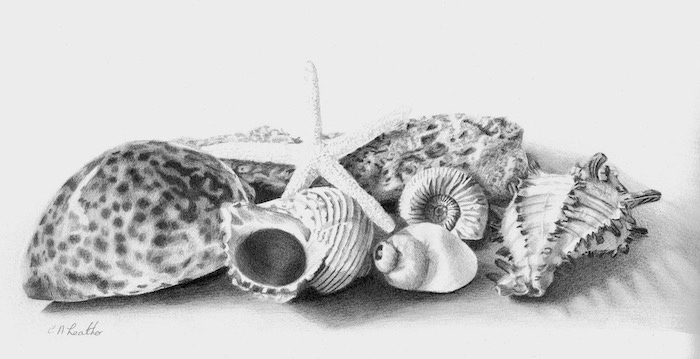 Still life in a variety of graphite pencils by Carol Leather
Still life in a variety of graphite pencils by Carol LeatherH-Grade Pencils (Hard)
- Range: 9H to H
- Composition: The H grades contain more clay. Higher numbers before the H mean the clay content is higher and the pencil harder.
- Characteristics: Light gray, sharp lines
- Best for: Technical drawings, precise details
B-Grade Pencils (Soft)
- Range: B to 9B
- Composition: The B grade pencils contain more graphite and less binder. Higher numbers before the B means a softer and darker mark is obtainable.
- Characteristics: Dark, smooth strokes
- Best for: Shading, expressive work
Middle Grade Pencils
- In the middle are the HB and F pencils.
- Balanced hardness and darkness.
- Ideal for general drawing and writing as they can be sharpened to a fine point that does not blunt quickly.
 Toby drawn in graphite by Carol Leather
Toby drawn in graphite by Carol Leather📌 Pro Tip: Most artists combine different grades in a single drawing for varied tones and textures.
Graphite pencils are the ones we are all familiar with, having used the HB (or no. 2 if you are in the US) since school.
They produce marks with a wide range of tones from silver grey to almost black.
Normally we will start working with pencils from the H end of the range to block out our shapes because the faint lines can be erased easily. However, its important not to press hard as otherwise you can indent the paper.
These light H-grade lines are also ideal for creating initial outlines for your coloured pencil pieces, as they erase cleanly and are less likely to smudge into your colours
Once you are satisfied with your placement of lines for your drawing, you can add the lightest shading with a slightly softer pencil, perhaps a 2H and then move up into the B pencils as you add the darker areas and tones.
Their main drawback with the darker B end is that the high concentration of graphite means a heavy application can produce a reflective shine when the light shines on it. Instead of getting a dark area you get a metallic effect that looks lighter than you intended.
However, it is clean to use and less smudgy than some of the other options.
Using Mechanical Pencils
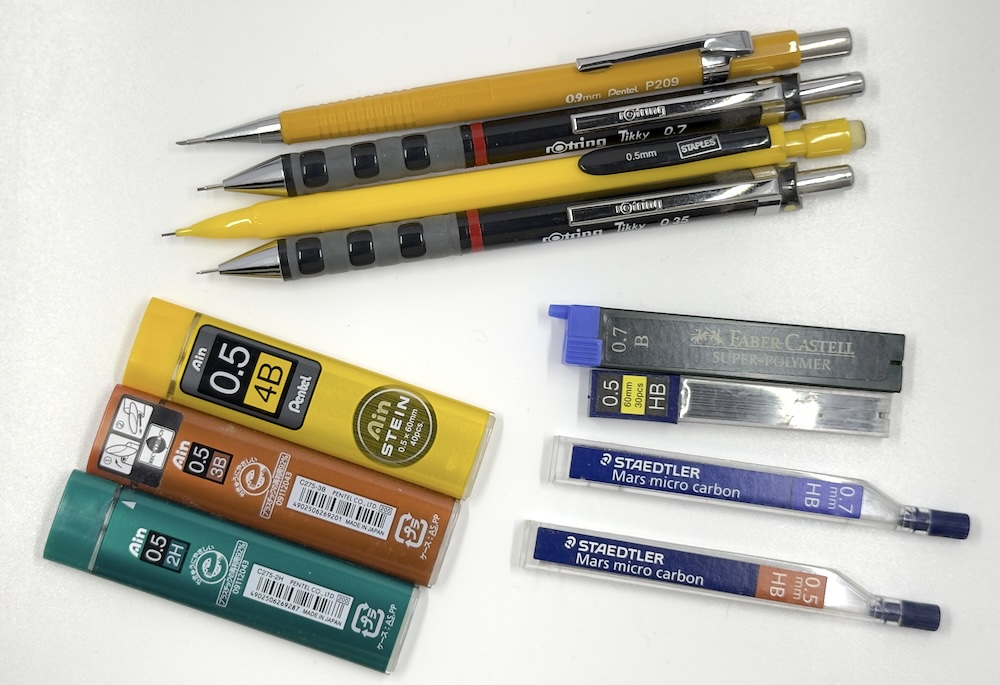 A selection of mechanical pencils using narrow keads.
A selection of mechanical pencils using narrow keads.Mechanical pencils (also known as propelling or clutch pencils) hold a refillable lead that extends at the tip by either pushing or twisting from the other end.
The size and weight of the pencil hardly changes as the slender lead inside is incrementaly fed though it. This gives the benefit of consistency for control and precision.
For coloured pencil artists, a mechanical pencil with a hard lead (like H or 2H) can be invaluable for creating light, precise guide drawings that won't interfere with subsequent colour layers.
However, the thin lead is prone to breakage under excessive pressure, which can be frustrating if you prefer bolder strokes or varying pressure levels.
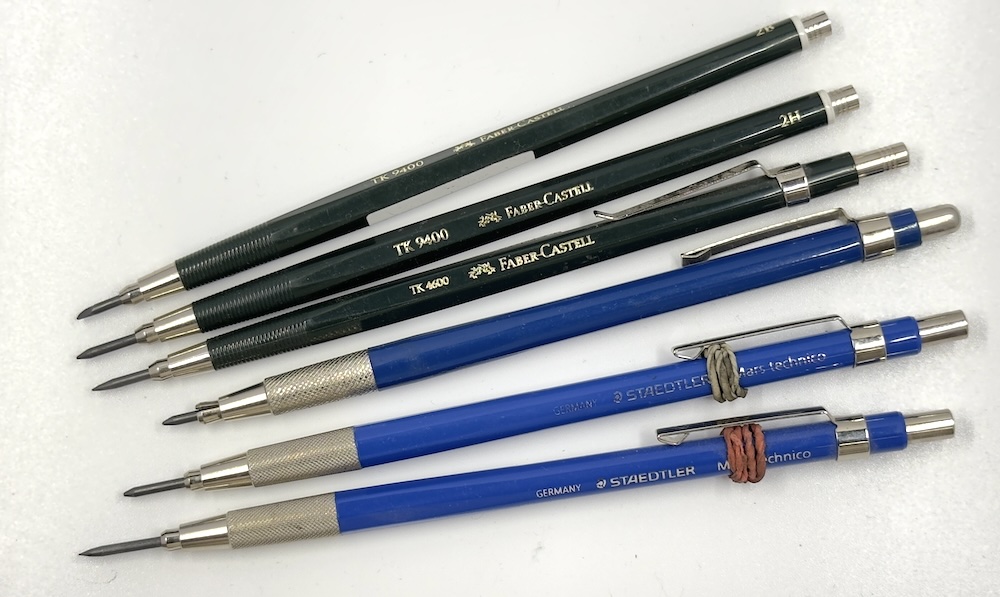 The coloured elastic bands remind me which lead is in which holder
The coloured elastic bands remind me which lead is in which holderLead Sizes and Grades
Standard mechanical pencils available on the high street are made to hold leads of betweeh 0.3mm and 0.7mm in diameter. It is also possible to buy 0.9mm versions.
Available from art shops are the lead holders, which generally take a 2mm lead. These can be made of plastic, or metal which is more durable and has more weight to it.
I find these thicker leads sometimes need sharpening to a point. But I also like to press a little harder and wear down one side then I have the option of a flat chisel point or a sharp edge, each of which can be used for different purposes.
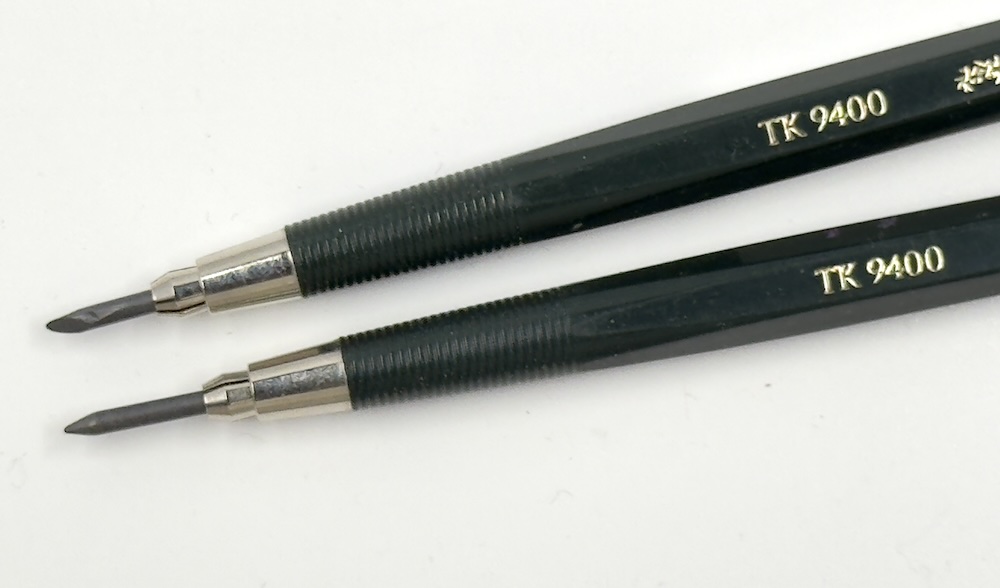 Can you see the flat, chisel surface on the underside of the top lead?
Can you see the flat, chisel surface on the underside of the top lead?Mechanical pencil leads also come in grades of hardness and softness, just like regular wood cased pencils.
But you know that problem when a wood cased graphite pencil becomes too short to fit in a sharpener, and you have to waste the end? This doesn't happen with a mechanical pencil.
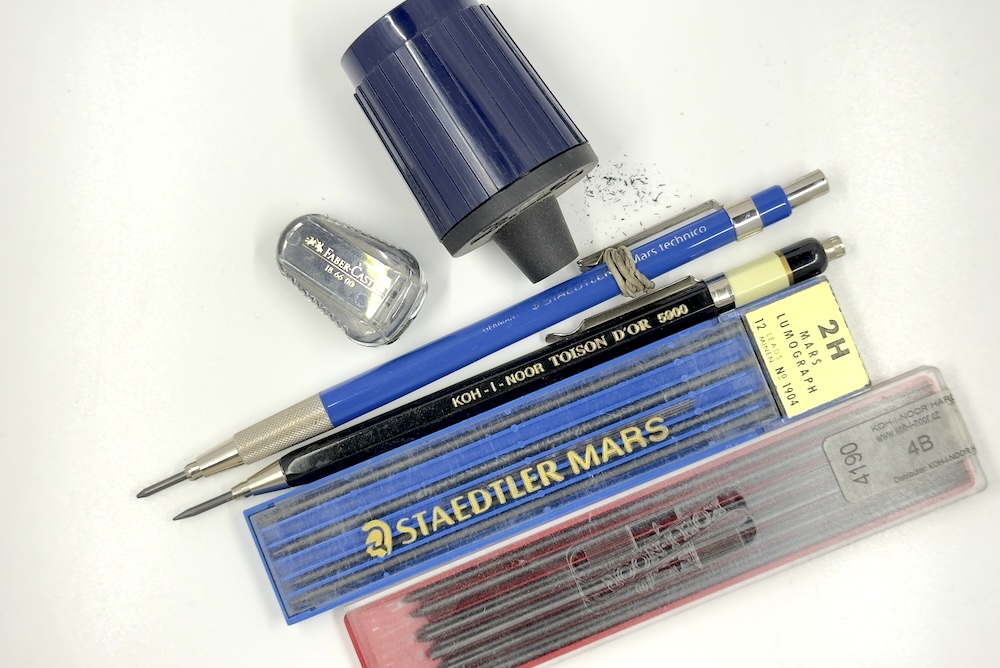
Exploring the Versatility of Charcoal
But graphite pencils aren't the only option for artists.
Charcoal pencils offer a different experience. Their rich, dark tones and smudgy texture create a distinct look that artists often favour in expressive and moody pieces.
Charcoal comes in several forms.
Vine Charcoal
Vine charcoal is a thin stick that breaks easily under pressure. This brittleness is due to it having no binder, it is pure burnt wood usually from a willow tree.
It can be messy to use and difficult to control which you might find frustrating if you prefer the precision of graphite.
Compressed Charcoal
Next we have compressed charcoal. This the vine charcoal ground into a powder which is then mixed with a binder to hold it together. It is darker and more intense than vine charcoal and like graphite, come in a series of grades (soft, medium and hard). A compressed charcoal stick or pencil can create rich, deep blacks, ideal for creating a high contrast drawing.
It is cleaner to use and stronger than vine charcoal. The paper also holds onto it better so it is less smudgy. However, this also means it can be difficult to erase or blend.
Wood cased Charcoal Pencils
When you put compressed charcoal in a wood casing you have a pencil that can be sharpened.
This will give you more precision when drawing allowing finer lines. You get the familiar feeling of using a pencil but the dark blacks of compressed charcoal without getting messy fingers.
The wood casing also minimizes breaking.
Did you know that you can combine charcoal, graphite, and carbon in the same drawing, or even use them selectively with coloured pencils for unique mixed-media effects?
 The original photo that Ed worked from was taken by artist Mel Williamson
The original photo that Ed worked from was taken by artist Mel Williamson Ed Kramer's charcoal pencil drawing based on the photo
Ed Kramer's charcoal pencil drawing based on the photoInvestigate the Unique Qualities of Carbon Pencils
One type of pencil we haven't covered yet is the carbon pencil.
These combine graphite and charcoal. Unlike graphite, they don't have the reflective quality and are smoother to apply than charcoal. Therefore you can get matte, deep black lines.
However, their intense blackness can make it harder to achieve subtle gradations and lighter tones, which may not be ideal for highlights or nuanced shading.
If you don't like the smudginess and brittleness of charcoal they may be a great addition to your pencil case. Only available for grades at the softer end (B to 6B) they are soft and free of grittiness that can cause scratching.
Your preference for carbon pencils depends on your personal style and the specific requirements of your artwork. You might enjoy their boldness or find them too restrictive and opt for more versatile options.
If you want dark blacks with no shine and detail that would be destroyed by the crumbly nature of charcoal, they may be just right for you, perhaps even for deepening the darkest matte areas in a predominantly coloured pencil piece.
Remember you can combine them with the other types of pencils in the same drawing.
It's Your Choice
The world of pencils is as diverse and varied as the artists who wield them.
You can explore, experiment with, and master each pencil type's unique qualities and challenges. The magic lies not in the pencil itself, but in the hand that holds it.
Enjoy the process of discovery and continuous learning, whether you're a seasoned artist or a beginner.
Dare to explore, make your mark, and let your art speak.
Start sketching your dreams today!
Improve Your Pencil Art: Get Free Tips & Techniques
Sign up for our newsletter – just occasional emails packed with practical advice and inspiration for pencil artists like yourself








